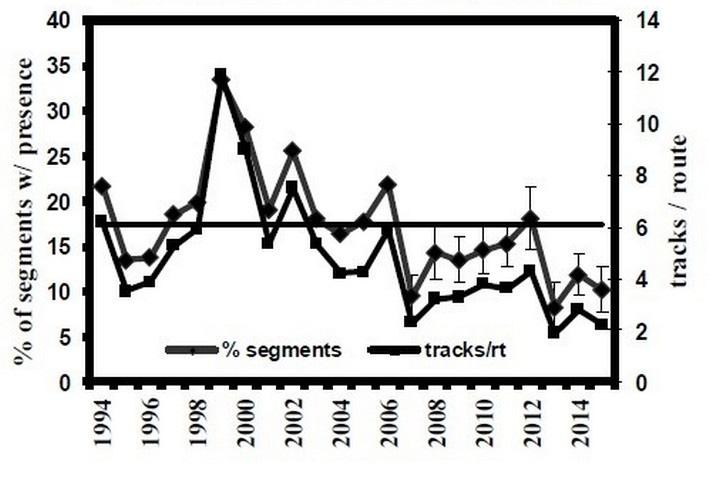
Description
Red foxes are medium-sized carnivores in the dog family (Canidae). The major identification challenge is distinguishing red foxes from gray foxes.
Red foxes have white tail tips, throats, and underfur, while gray foxes have black tail tips and yellow or orange coloration on a white throat/underfur. Red foxes tend to be slightly heavier than gray foxes, and red foxes have slightly longer muzzles than gray foxes. A few red foxes are black or silver in coloration, which reflects normal genetic variation within the species.
Size
Measurements from Minnesota are from Hazard (1982), from Wisconsin are from Jackson (1961), from Iowa are from Storm et al. (1976), and from the Eastern United States are from Hamilton and Whitaker (1998).
Male total length averaged 41.5” (1,055 mm) in Minnesota and 39.3” (998 mm) in Iowa, ranged from 38.6” to 43.9” (980-1,115 mm) in Minnesota and from 37.6” to 41.1” (954-1,045 mm) in Iowa. Female total length averaged 37.2” (946 mm) in Iowa, and ranged from 33.1” to 40.2” (842-1,020 mm) in Iowa. Total length averaged 38.3” (972 mm) in Eastern United States, and ranged from 38.4” to 41.3” (975-1,050 mm) in Wisconsin. Male tail length averaged 15.6” (396 mm) in Minnesota and 14.1” (359 mm) in Iowa, and ranged from 14.0” to 16.5” (356-420 mm) in Minnesota and 12.6” to 15.4” (320-390 mm) in Iowa. Female tail length averaged 13.3” (337 mm) in Iowa, and ranged from 11.6” to 14.5” (294-368 mm) in Iowa. Tail length averaged 14.6” (371 mm) in Eastern United States, and ranged from 13.0” to 15.9” (330-405 mm) in Wisconsin. Male body weight averaged 11.2 lb (5.1 kg) in Minnesota and 10.6 lb (4.8 kg) in Iowa, and ranged from 9.5 to 13.4 lb (4.3-6.1 kg) in Minnesota and 9.0 to 12.6 lb (4.1-5.7 kg) in Iowa. Female body weight averaged 8.6 lb (3.9 kg) in Iowa and ranged from 6.6 to 10.1 lb (3.0-4.6 kg) in Iowa. Adult body weight averaged 10-11 lb (4.5-5 kg) in Eastern United States.
Males are typically larger than females.
Distribution & Status
Red fox have the widest distribution of any carnivore, and are found throughout much of the northern hemisphere (Hazard, 1982). In North America, red fox can be found from the Arctic Circle to the southeastern United States, with more limited distribution in the western United States. There is some debate whether red foxes in the New World merit species status (Vulpes fulva) separate from Old World red foxes, and whether red foxes were introduced to the New World (IUCN, 2017).
Worldwide, Vulpes vulpes is found throughout the Northern Hemisphere. Other Vulpes species occur on all continents except South America, Australia, and Antarctica.
Red foxes have an IUCN rank of Least Concern, IUCN information here
Incidence in Minnesota
Trapping for red fox, gray fox, raccoon, and badger are jointly administered in Minnesota, typically allowed from fall through spring. In 2017-2018, open season will be from October 14th through March 15th. Hunting and trapping are regulated by the Minnesota Department of Natural Resources, regulations here
From winter track data (1994-2015) it appears that Minnesota red fox populations are stable below their long-term average (Erb 2015).
Population Trends
To help assess population trends, we can look at regional furbearer harvest data, methods here.
Regional harvest was relatively stable from the 1970s through the late 1990s, when harvest plummeted. Harvest levels have been relatively constant at a lower level from the late 1990s until the present.
Each state and province makes a measurable contribution to regional red fox harvest.
Life History
Red foxes mate in January and February, with 3-7 kits born after a 52 day gestation. Families occupy ground burrow dens, and stay together until September-October, when each animal becomes relatively solitary and disperses. Dens typically have multiple entrances, and parents may move young between dens, with litter sometimes split between two dens (Chapman and Feldhamer, 1982). Kits open their eyes after a week, and begin to walk at three weeks. Red foxes hunt primarily at night, and eat a variety of small mammals, birds, snakes, turtles, frogs, insects, and fruit. Diverse landscapes are favored, offering a variety of hunting opportunities. Mice and voles are common prey. Coyotes, cougars, lynx, and other larger carnivores are known to prey on red foxes.
Contacts with Humans
Red foxes are sometimes trapped for their fur, if they are viewed as a threat to poultry or pheasant farms, or if a red fox is suspected to be infected with rabies. Foxes can seriously impact poorly maintained poultry farms, and are potential vectors for diseases. Some foxes are hunted for sport with hounds and horses. Red foxes help curb small mammal populations.






